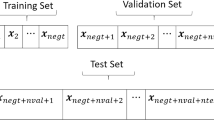Abstract
In order to improve the stock price prediction effect, based on the improved PSO algorithm, this paper constructs a stock price prediction model through neural network. Based on the idea of avoiding particles falling into the same local solution as much as possible and always keeping the particles with a certain diversity, in order to improve the global search ability of the algorithm in the early stage of evolution and the local search ability in the later stage of the evolution, the adaptive adjustment of inertial weight is proposed, and the algorithm is improved by combining with neural network. In addition, on the basis of the improved algorithm, this paper constructs a stock price prediction system based on neural network. Finally, this paper designs experiments to verify the function of the model from the perspectives of stock data collection and processing, and stock price prediction accuracy, and draw statistical graphs based on the statistical research results. The results of the research show that the system constructed in this paper has a certain practical effect.









Similar content being viewed by others
Data Availability
Not applicable.
References
Alexandri MB, Anjani WK (2014) Income smoothing: impact factors, evidence in Indonesia. Int J Small Bus Entrep Res 3(1):21–27
Alquraan T, Alqisie A, Al SA (2016) Do behavioral finance factors influence stock investment decisions of individual investors?(Evidences from Saudi Stock Market). J Am Sci 12(9):72–82
Apergis N, Simo-Kengne B, Gupta R (2014) The long-run relationship between consumption, house prices, and stock prices in South Africa: evidence from provincial-level data. J Real Estate Lit 22(1):83–99
Arshed N, Anwar A, Hassan MS et al (2019) Education stock and its implication for income inequality: the case of Asian economies. Rev Dev Econ 23(2):1050–1066
Asghar MZ, Subhan F, Ahmad H, Khan WZ, Hakak S, Gadekallu TR, Alazab M (2020) Senti-eSystem : a sentiment-based eSystem -Using hybridized fuzzy and deep neural network for measuring customer satisfaction. Softw Pract Exp 51(3):571–594
Baker SR (2018) Debt and the response to household income shocks: Validation and application of linked financial account data. J Polit Econ 126(4):1504–1557
Banam M, Mehrazeen A (2016) The relationship of information asymmetry, Institutional Ownership and Stock Liquidity with Income Smoothing in Tehran Stock Exchange. J Manag Account Stud 4(03):6–11
Bengtsson E, Waldenström D (2018) Capital shares and income inequality: evidence from the long run. J Econ Hist 78(3):712–743
Carvalho L, Di Guilmi C (2020) Technological unemployment and income inequality: a stock-flow consistent agent-based approach. J Evol Econ 30(1):39–73
Chen S, Komal B (2016) Impact of stock market development on economic growth: evidence from lower middle income countries. Manag Adm Sci Rev 5(2):86–97
Dafermos Y, Papatheodorou C (2015) Linking functional with personal income distribution: a stock-flow consistent approach. Int Rev Appl Econ 29(6):787–815
Gantino R (2015) Effect of managerial ownership structure, financial risk and its value on income smoothing in the automotive industry and food & beverage industry listed in indonesia stock exchange. Res J Finance Account 6(4):48–56
Gómez JP, Priestley R, Zapatero F (2016) Labor income, relative wealth concerns, and the cross section of stock returns. J Financ Quant Anal 51(4):1111–1133
Hoffmann M (2014) The consumption–income ratio, entrepreneurial risk, and the us stock market. J Money Credit Bank 46(6):1259–1292
Jay P, Kalariya V, Parmar P, Tanwar S, Kumar N, Alazab M (2020) Stochastic neural networks for cryptocurrency price prediction. IEEE Access 8:82804–82818
Khan HH, Naz I, Qureshi F et al (2017) Heuristics and stock buying decision: Evidence from Malaysian and Pakistani stock markets. Borsa Istanbul Rev 17(2):97–110
Li G (2014) Information sharing and stock market participation: Evidence from extended families. Rev Econ Stat 96(1):151–160
Mohammadi MY, Arman MH (2016) The survey of accounting variables effect on incomesmoothing in stock exchange companies. J Fundam Appl Sci 8(2):1257–1271
Nazar SN, Ekowati T, Setiyawan H (2017) Does income smoothing improve informativeness of stock prices? Jurnal Ilmiah Econ 15(2):225–239
Nguyen T, Duong HN, Singh H (2016) Stock market liquidity and firm value: an empirical examination of the Australian market. Int Rev Financ 16(4):639–646
Ruan J, Hu X, Huo X, Shi Y, Chan FT, Wang X, Zhao X et al (2019) An IoT-based E-business model of intelligent vegetable greenhouses and its key operations management issues. Neural Comput Appl 32(19):15341–15356
Saez E, Zucman G (2016) Wealth inequality in the United States since 1913: Evidence from capitalized income tax data. Q J Econ 131(2):519–578
Shin SH, Kim KT (2018) Income uncertainty and household stock ownership during the great recession. J Financ Couns Plan 29(2):383–395
Voelzke J (2016) Individual labour income, stock prices and whom it may concern. Appl Econ Lett 23(13):965–968
Funding
No funding support were received by the co-authors.
Author information
Authors and Affiliations
Contributions
FY presented the concept and wrote the manuscript with the help of all of the authors. JC created the model and carried out the validation and resources. YL performed the experimental analysis and assisted in the review and editing of the manuscript.
Corresponding author
Ethics declarations
Conflict of interest
No conflict of interests among the authors.
Animal Research (Ethics)
Not applicable.
Consent to Participate (Ethics)
Not applicable.
Consent to Publish (Ethics)
The author declares that their contribution is original and has the full power to make this consent.
Plant Reproducibility
Not applicable.
Additional information
Communicated by Vicente Garcia Diaz.
Publisher's Note
Springer Nature remains neutral with regard to jurisdictional claims in published maps and institutional affiliations.
Rights and permissions
About this article
Cite this article
Yang, F., Chen, J. & Liu, Y. Improved and optimized recurrent neural network based on PSO and its application in stock price prediction. Soft Comput 27, 3461–3476 (2023). https://doi.org/10.1007/s00500-021-06113-5
Accepted:
Published:
Issue Date:
DOI: https://doi.org/10.1007/s00500-021-06113-5




